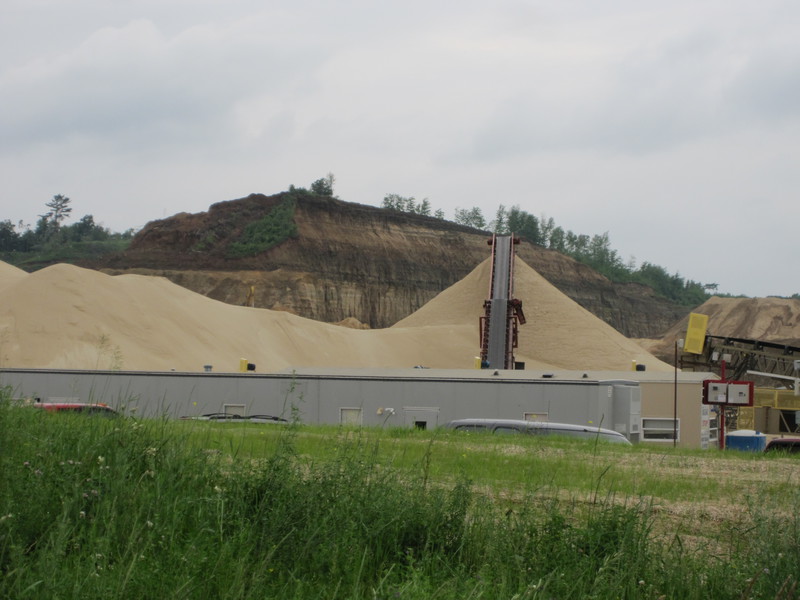
nonmetallicmining;
Introduction
Intro to nonmetallic mining and common potential problems, with specific intros to silica mining (note: silica mining NAICS code: 212322) and to coal mining-- such as, most do not have to report TRI, but do have to obtain air permits; mention NAAQS. Visual aid to help explain types of emissions and pathways of exposure.
Industrial Sand Mining
information transcluded to Background Information on www.publiclab.org/wiki/frac-sand
Industrial sand mining involves extraction of sandstone, generally through displacing overlying land, excavating hillsides, crushing rock, and sorting resultant sand and gravel. Sand is mostly comprised of silica, which is a very hard crystalline mineral with high compressive strength. When silica is pulverized, very small fragments are created, which are small enough to become airborne. Airborne silica that is smaller than four micrometers in diameter (4 um, also written as PM4) is respirable, and breathing it in can create long-term lung damage. Due to the mineral’s hardness, silica can tear lung tissues and cause scar tissue to build up and inflammation in lung tissues, both of which impact a person’s ability to breathe, and can be fatal. Workers at industrial sand mining operations, and people living and working nearby, may be exposed to respirable silica. Additionally, areas where these operations occur likely have elevated concentrations of other airborne particulate matter, which are generally classified by size as fine (PM10, less than 10 um diameter) and ultrafine particles (PM2.5, less than 2.5 um diameter), which have demonstrable effects on cardiac and lung health.
While industrial sand mining has occurred for more than a century, the volume of sand produced has increased substantially in recent years. With the U.S. natural gas production increase due to the mass adoption of hydraulic fracturing and horizontal drilling, the need for silica as proppant material (used to prop open fractures in the source rock to allow gas to escape up into the well) has increased as well. This industrial sand used in hydraulic fracturing, known as “frac sand” must be highly uniform, able to withstand high pressure, and well-rounded. The production of frac sand increased by an order of magnitude from 2007 to 2014, with approximately 54 mega tons of frac sand produced in the US in 2014 (Bleiwas, 2015; USGS 2007), and the market share grew to approximately 33% of industrial sand market value (Bleiwas, 2015; USGS 2015). The primary source location for frac sand is the Great Lakes region, especially western Wisconsin, which produced nearly half of domestic frac sand in recent years (Bleiwas, 2015). Western Wisconsin is home to Cambrian and Ordovician sandstone formations, created when this area was covered by a great inland ocean from ~540 to 360 million years ago. The high silica content and well-rounded grains of Wisconsin sandstones, and their shallow depth, plus the fairly dense railroad network for transport, make Wisconsin the prime location for frac sand mining. As of December 2015, Wisconsin had 129 industrial sand mining facilities, ranging in size from 9 to 4000 acres (Wisconsin DRN, 2015).
Communities in western Wisconsin are faced with the environmental impacts of industrial sand mining and processing for frac sand. The impacts of this industry on neighboring communities are diverse, from light and noise pollution to roadway infrastructure damage by increased truck traffic, from accelerated erosion and sediment loads in stormwater runoff to airborne particulate matter. To address some of these issues, the state of Wisconsin requires frac sand facilities, along with other nonmetallic mining operations, to comply with air and water permits, which may or may not be sufficient to adequately protect the environment. Other issues are not addressed in permits or regulated by the state, but townships may develop the opportunity to address them. Concerned citizens in several counties have initiated research into the local impacts -- positive and negative -- of frac sand mining operations, and certain townships have required special licenses to operate in their town, the regulation of which allows the townships to more adequately address environmental and public health and safety issues.
Cited References:
U.S. Geological Survey. 2013 (published 5/2015). Minerals Yearbook: Silica.
Wisconsin Department of Natural Resources. 2015. Industrial Sand Mining.
Environmental Concerns Related to Nonmetallic Mining
Airborne compounds that may be associated with mining: Particulate Matter (including silica, coal dust, and combustion aerosols from mining product transport)
[make links to various chemicals that might be used like cyanide or degreasers?]
Water-related issues associated with nonmetallic mining operations: www.publiclab.org/wiki/water/nonmetallicmining.
Land-related issues associated with nonmetallic mining operations: www.publiclab.org/wiki/land/nonmetallicmining.
Communities with Nonmetallic Mining
Learn about communities addressing environmental concerns associated with nonmetallic mining: www.publiclab.org/wiki/peopleandplaces#wisconsin.
To join the discussion, join our group email list: plots-airquality@googlegroups.com
Ask a question on the Public Lab website here: [button for when that is an option].